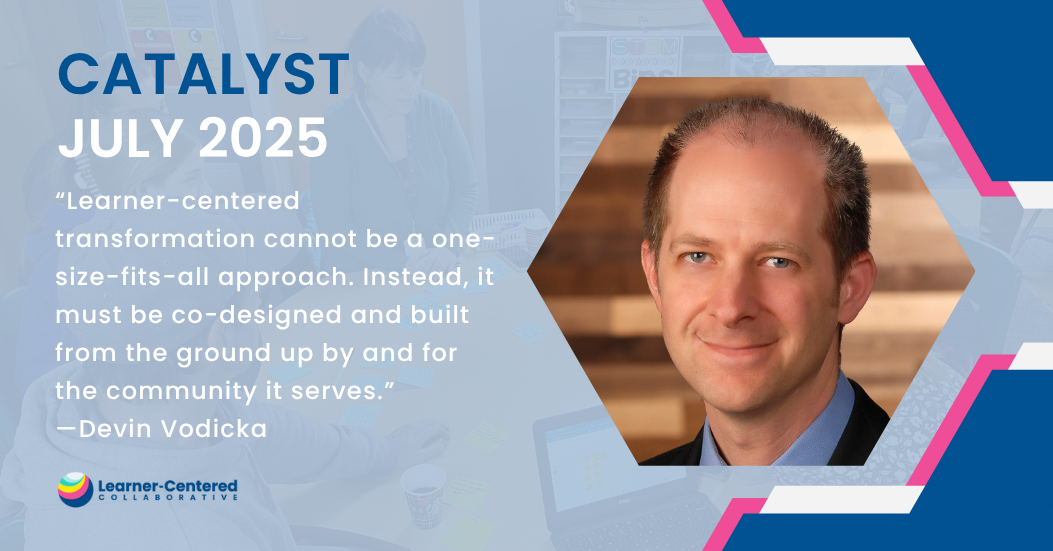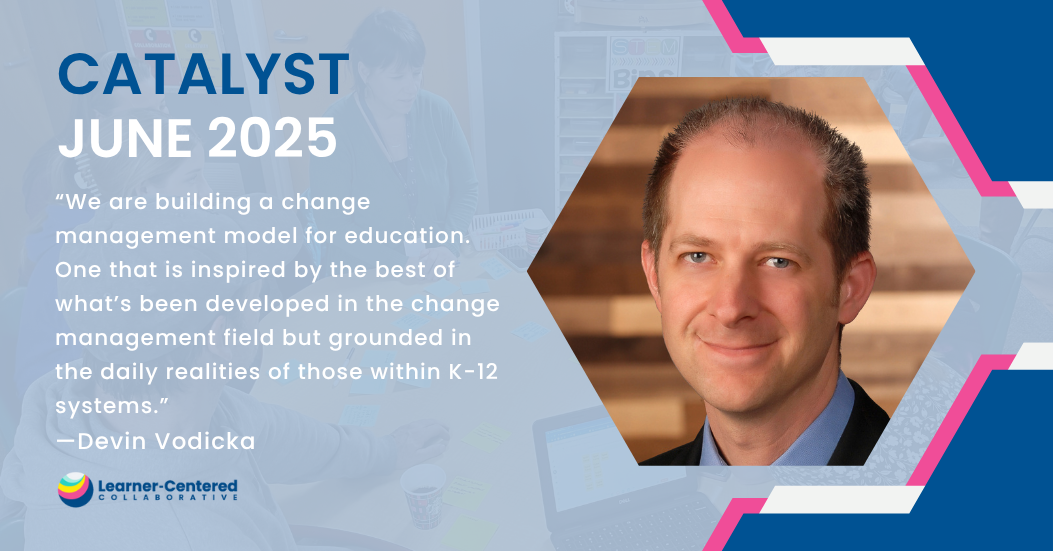Blog
AI as my Teaching Assistant: Tools, Strategies, and Lessons Learned
By Shannon Roos, English Teacher and Instructional Coach at Hampton High School Three years ago, I sat in my classroom thinking through an overwhelming challenge our administration had just presented to the instructional coaching team: make sense of Artificial Intelligence (AI) and put together a lunch and learn session that we would present to our…
Blog
Designing for What Matters Most: How Unit Design PD Brings Our Learner Profile to Life
By Chad Mabery, Ed.D., Assistant Superintendent of Instructional Services at Laguna Beach Unified School District “Have you ever taught a unit of study that students just don’t seem to enjoy? Do you have a unit of study that you dread teaching every year? We’ll pay you to redesign it!” That’s the sales pitch through…
Blog
Building Brighter Futures Together: Insights from the SoCal LiNK Regional Partnership
A fresh model of collaboration is emerging in Southern California; one that unites K–12 education, higher education institutions, and local communities with a shared focus on supporting the whole learner. SoCal LiNK, Southern California Learning in Networked Knowledge, is a research-practice partnership between the Department of Education Studies at UC San Diego, Learner-Centered Collaborative…
Blog
What is the Purpose of School? A Call for Whole-Learner Outcomes.
What is the purpose of school? For the past four decades, the prevailing national answer—shaped largely by the 1983 report “A Nation at Risk” and documented by historian Patricia Graham—has been singular: Achievement. This focus helped usher in an era of standardization, compliance, and testing. It was designed to respond to global economic anxieties…
Blog
4 Lessons From a Competency-Based Community of Practice
No one has completely figured it out, but everyone has something to offer. This sentiment captures the spirit of this year’s Competency-Based Community of Practice. This virtual group is made up of 45 teachers and leaders from nine schools and districts across the country who are currently implementing competency-based assessment and reporting practices. They…
Blog
Celebrating Bright Spots in Learner-Centered Education: Looking Ahead to What’s Possible
As the school year winds down, we’re taking a moment to reflect on the incredible progress made in the journey toward learner-centered education. Across classrooms, schools, and districts, we witnessed bold steps, powerful moments of growth, and inspiring examples of what’s possible when we center learners by design. Learner Agency in Action This school…
Blog
It’s Time for a Change Management Model Built for Learner-Centered Education
How often have we heard learners (adults included) ask, “Why do I need to know this?” It’s a question as old as formal education itself, and one we should never stop thoughtfully addressing. The likelihood of achieving our desired outcome diminishes when the “why” is unclear in any context. This is just as true…
BlogWebinars
Webinar Recording: Bridging Systems to Transform Student Learning: Lessons From SoCal LiNK
In this webinar, five education leaders share lessons from their experience with SoCal LiNK, a Southern California regional network focused on advancing learner-centered education through collaboration, research, and community building. The webinar panel includes representatives from K–12 schools, higher education, and learner-centered organizations, specifically: Devin Vodicka (LCC Co-CEO), Dr. Alan J. Daly and David…
Blog
Lake Living and Life Lessons: A 12th Grader’s Reflection on Learner-Centered Education in the Upper Peninsula
By Everest Orlikowski, Student at Clark Street Community School If you had the chance to learn about anything you wanted, what would you explore and how would you do it? My high school, Clark Street Community School (CSCS) in Middleton, Wisconsin, presents students with this choice many times throughout our secondary education which allows…
Blog
Can Regional Innovation Hubs Create a More Promising Future for K-12 Education?
Written in collaboration with leaders from AERDF, ALI, InnovateEDU, Leanlab Education, and Learner-Centered Collaborative Throughout history, moments have invited us to rethink how learning happens, who it serves, and what it could become. And yet, many of these opportunities have come and gone without the lasting change they promised. The COVID-19 pandemic is one…
Blog
Lessons From a Principal: What it Takes to Build a School Where Students Drive Their Own Learning
Creating a school where students take ownership of their learning is a transformative journey that requires vision, commitment, and a willingness to rethink traditional structures. For students to truly be the leaders of their own learning in the classroom, schools must first be led by empowered teachers. When teachers have autonomy, support, and structures…
Blog
Leading Through Transition: Leadership Lessons for Summer and Beyond
In education, the rhythm of the year is deeply cyclical. Each year forms a distinct cohort experience for learners, educators, and families alike. When the cohort concludes, there is a natural transition into the unknown. Students move to new grade levels, teachers adapt to new assignments or even new campuses, and leadership teams lay…
BlogWebinars
Webinar Recording: Learner-Centered Bright Spots: Making Learning Public and Closing the Year Strong
In this webinar, three members of the Learner-Centered Collaborative team—Katie Martin, Kate Weisberg, and Danny Scuderi—highlight practical strategies for closing the school year by celebrating learning and cultivating learner-centered mindsets. Drawing from their work in classrooms and systems nationwide, they offer tangible examples of how schools and educators can use reflection, celebration, and community-building…
Blog
A Learner-Centered Approach to Expanding Advanced Placement and Dual Enrollment for Native American Students
Written by Keisha Lanier Brown, Ph.D. Student, Georgia State University Through the inaugural Learner-Centered Assessment Fellowship, Digital Promise and Learner-Centered Collaborative brought together early-career scholars, education partners, and mentors to explore the potential of collaboration and culturally responsive approaches to educational assessment. As a final reflection and celebration of their work, each of the…
Blog
From the Classroom to the Cosmos: Passion Projects as a Tool for Real-World Learning
“My favorite part of my passion project was when astronaut Kevin explained that Mars rocks are in the Arctic ice. It was so cool to know that we can learn a lot about Mars here on Earth instead of going to Mars,” said Owen, a space-obsessed fifth grader. My son, Owen, didn’t just complete…
Blog
The Impact of Innovation Cohorts: A Research-Based Perspective on Educator Growth
Written by Anna Yinqi Zhang, Ph.D. Candidate at Pennsylvania State University. Through the inaugural Learner-Centered Assessment Fellowship, Digital Promise and Learner-Centered Collaborative brought together early-career scholars, education partners, and mentors to explore the potential of collaboration and culturally responsive approaches to educational assessment. As a final reflection and celebration of their work, each of…
Blog
This is What Happens When Every Learner Can Confidently Talk About Their Learning
Shifting to learner-centered education is both an iterative process and a collective effort. Our Connections Leadership Cohort recently got an opportunity to see a learner-centered ecosystem firsthand in New York, at Mineola Public Schools, while building stronger bonds within their own teams and across schools. Beginning with 3rd and 4th grade students greeting us…
Blog
Purpose, Participation, and Feedback: What it Takes to be a Learner-Centered Leader
Too often, leadership is viewed as a position rather than a practice—something tied to a title rather than a way of engaging with others to drive meaningful change. In today’s rapidly shifting educational landscape, that perspective is proving insufficient. With rising rates of superintendent and principal turnover, teacher burnout, and declining enrollment, it’s clear…

















